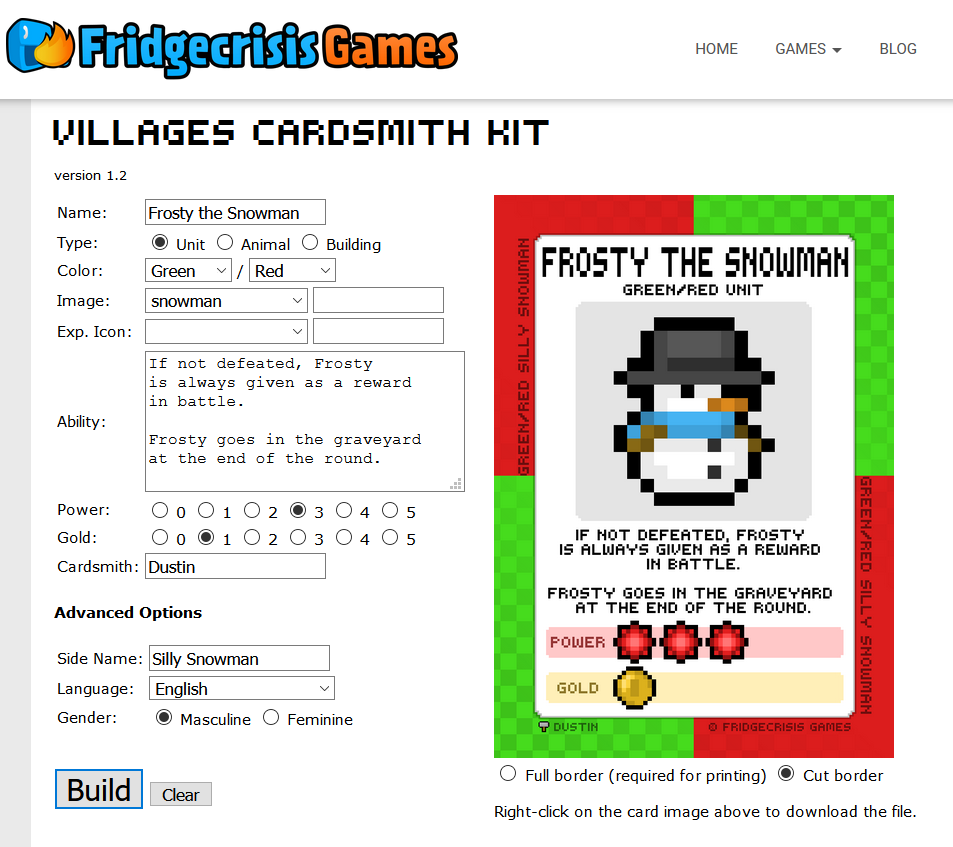Guild Update
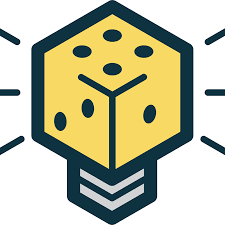
COVID and Guild Playtest Meetings
Currently we are allowing playtest facilitators for each location to determine if meetings will be held, as long as they fall within state guidelines. Updates on the status of these meetings will be announced via our BGDG of Utah’s Facebook Group.
Discord and the Guild
The BGDG of Utah’s Discord is a great way to get to know those in the guild and discuss all things game design! If you’ve not joined yet, we’d love to have you come and participate with us!
Comprehensive List of Games
Dustin Dowdle would like to create a comprehensive list of games by guild members, which would be available both on our guild’s website (bgdg.games as well as on Board Game Geek). Dustin will only plan on including games that the designer’s themselves submit, as he does not want to falsely attribute a game’s involvement in the guild if the designer doesn’t wish to be associated. With that being said, any published game (self published, crowdfunded or traditional publishing) that a guild member has worked on is welcome to be included in this list. Please contact Dustin at oddfoxgames@gmail.com or bgdgofutah@gmail.com to have your game added to the list.
Tabletop Simulator Event
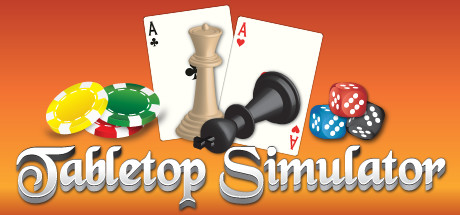
We are currently planning to hold a guild playtesting event in February on Tabletop Simulator and would love as many participants as possible! In order to help make this a successful event we are planning another event in January to help teach how to use Tabletop Simulator and answer questions. If you are interested in helping with either event then contact Please contact Dustin at oddfoxgames@gmail.com or bgdgofutah@gmail.com.
Upcoming/Current Events
Recent Game News from the Guild
Faction Fighters by Paige and Aaron Treglown is currently on Kickstarter
Crowd Ox merges with Backer Kit. See the details here.
Print and Play
Sleeping Gods Primeval Peril is a standalone, spoiler free, demo campaign for 1-2 players. The files can be downloaded from Drop Box here.
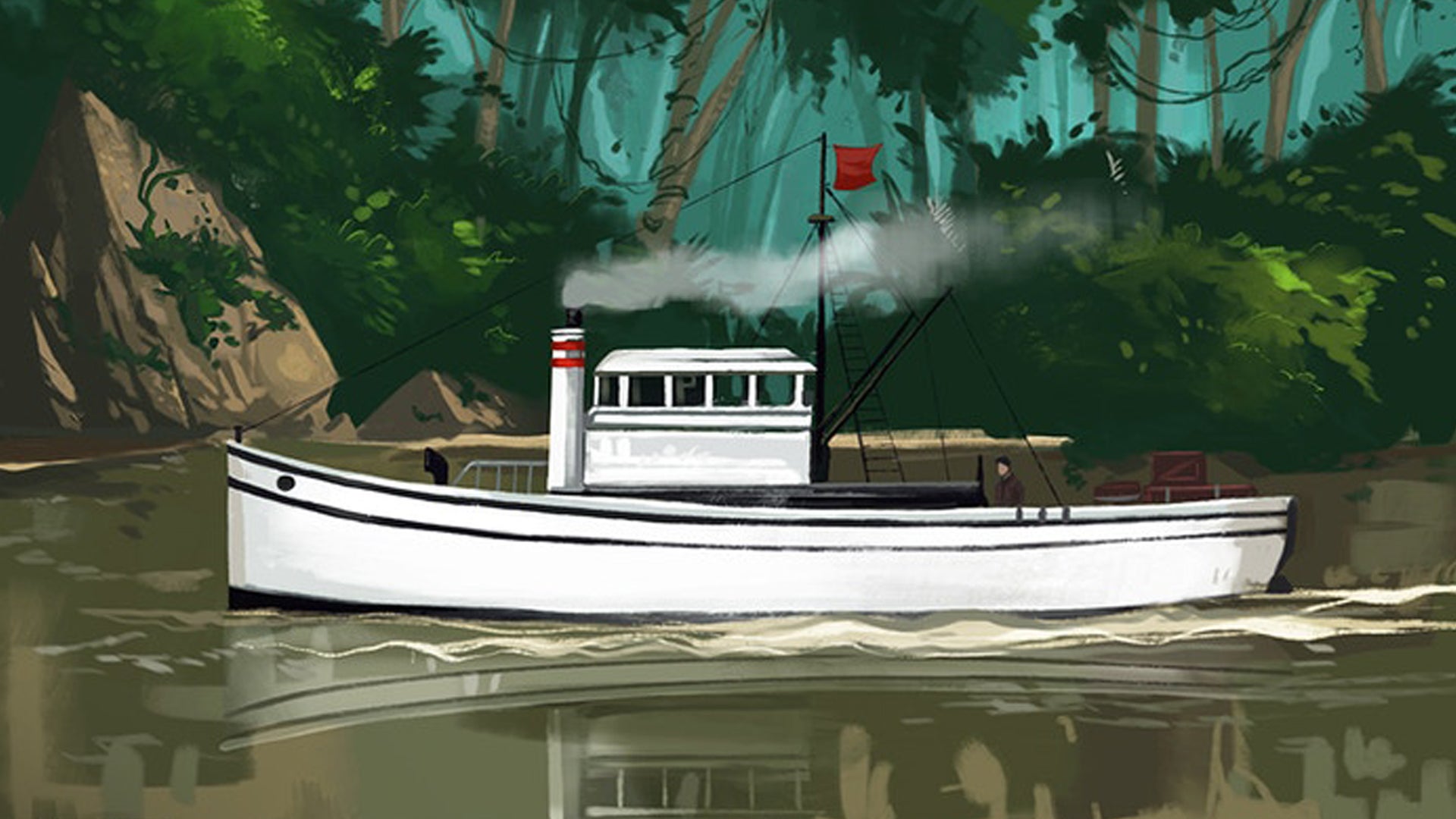
You can play a demo copy of the game Faction Fighters. See download below:
Current Design Contests
Community Anthology Design Contest (01/04/21 The Game Crafter)
Zenobia Award Contest (01/15/21)
Roll and Write Game Design Contest (01/15/21 BGG)
54 Card Contest (04/30/21 BGG)
Guild Related Videos and Reviews
Brandt Brinkerhoff recently posted a how to play video for his game Oros
Ryan Laukat’s game Exile, which very little is known about, was featured as one of the top upcoming Kickstarter Games for 2021. You can read more about what was said in the link below:
Meeple Nation discussed their play of Faction Fighters near the end of the show.
Design your own Villages Cards!
You can design and customize your own cards for Jaron Frost’s game Villages with the Villages Cardsmith Kit and either print them out yourself or have them professionally printed and mailed to you (minimum of 8 cards per order).
Utah Boardgame Stores and Designers Facebook Group
Guild member Nick Keil has started a Facebook Group called Utah Boardgame Stores and Designers. It’s sort of a sister group for the Utah Board Game Exchange. Specifically for Friendly Local Games Stores (FLGS) & Designers in UTAH to post Weekly Specials, Deals, as well as a LOCAL Utah Game Designer’s Game Launches on Kickstarter or other Crowdfunding Platforms. Feel free to check it out at the link above!
Nerding Out Podcast
Nerd Out with Riley Stock (game designer and guild member) and Danny Dowdle (amazing painter of miniatures). We talk board games, board game design, comicbooks, movies, TV, video games, and really anything that we can nerd out about.
Board Game Workshop Podcast
Chris Anderson and Dustin Dowdle (guild member) discuss all things game design:
Game Design Highlights by Skye Larsen
Learning from video games
As someone who slowly merged (after signaling of course) into the board games lane during an attempt at an indie video game, much of the advice I’ve read or heard about game making kind of blends together. There are certainly important differences between making a game that ends up on PCs versus the tabletop. But I think the two crafts share plenty of commonalities.
In this article I wanted to take a look at some great design conversations about digital games, and include a couple thoughts on how I think they can apply to board game design as well.
#211 SLAY THE SPIRE – A DESIGNERS DEEP DIVE WITH ANTHONY GIOVANNETTI
Slay the Spire itself blurs the line between video game and tabletop card game. Players build a deck of cards over the course of each game, playing cards from their hand to defeat a series of monsters, random events, and difficult bosses. The video game element allows players to fail and restart seamlessly, as well as interesting mechanics like transforming cards—but at its heart the game is a solo card game. So it’s no surprise that much of the advice in this chat with Slay the Spire’s designer would apply to both genres.
A couple parts of this conversation intrigued me. One was a discussion on how Mega Crit approached synergies in a deckbuilding game without relegating players to the exact same decks each time. Another important topic is the idea of “overpowered cards” and why they might be okay in the instance of Slay the Spire.
Game Maker’s Toolkit – What Makes a Good Puzzle
All of Mark Brown’s videos are well researched and expertly presented, but this video on What Makes a Good Puzzle was one of my favorites. He’s not a designer himself (that I know of) but he has a good critical eye for discussing game design across many video game genres.
As he dissects the design of popular digital puzzle games, he talks about the importance of the catch and the following revelation. The catch is where a seemingly straightforward puzzle has a hitch, and the revelation is how the player not only solves the catch, but learns something new for future puzzles. Another section discusses the importance of feedback with puzzle design, which can rescue players early from incorrect paths to the solution.
Design Doc – The Best & Worst of Graphic Design in Games
I don’t follow the Design Doc as closely as his YouTube counterpart Mark Brown, but he puts out some great design videos as well. I especially like his series on graphic design, and this is the introduction to that series.
While this video could’ve devolved into heaping praise on certain titles and dunking on bad design, this video instead explains why some video game graphic design succeeds and other designs fail. While not all the graphic design elements map to a tabletop game (unless you can get Jack Black to record an intro for your game’s rulebook!) most of the principles do. The Design Doc shows very clearly how you can manage an attractive and thematic user interface without sacrificing too much clarity.
Ryan Clark – What Makes an Indie Hit? How to Choose the Right Design
Ryan Clark is a successful indie video game designer, and in this (relatively) famous talk he shares his thoughts on how to make a hit video game in a crowded space. While the board game design scene isn’t currently quite as crowded, there’s still plenty of competition out there when it comes to attention for your game.
Hooks. That’s the short answer to Ryan’s question in the title. Thankfully, he expounds on the topic of hooks throughout the article and shows how to analyze your own hooks independently as well as part of a larger ecosystem. I love a specific bit of advice on finding the 10 closest games to yours and examining how well each game did in the market.
I hope you find these video game discussions helpful for your own tabletop designs. While there is a lot of great design advice out there targeted specifically to board game designers, you’ll miss out on some excellent advice if you don’t listen to what other game designers (or even designers in general!) are up to.
Interview with Robin Armstrong
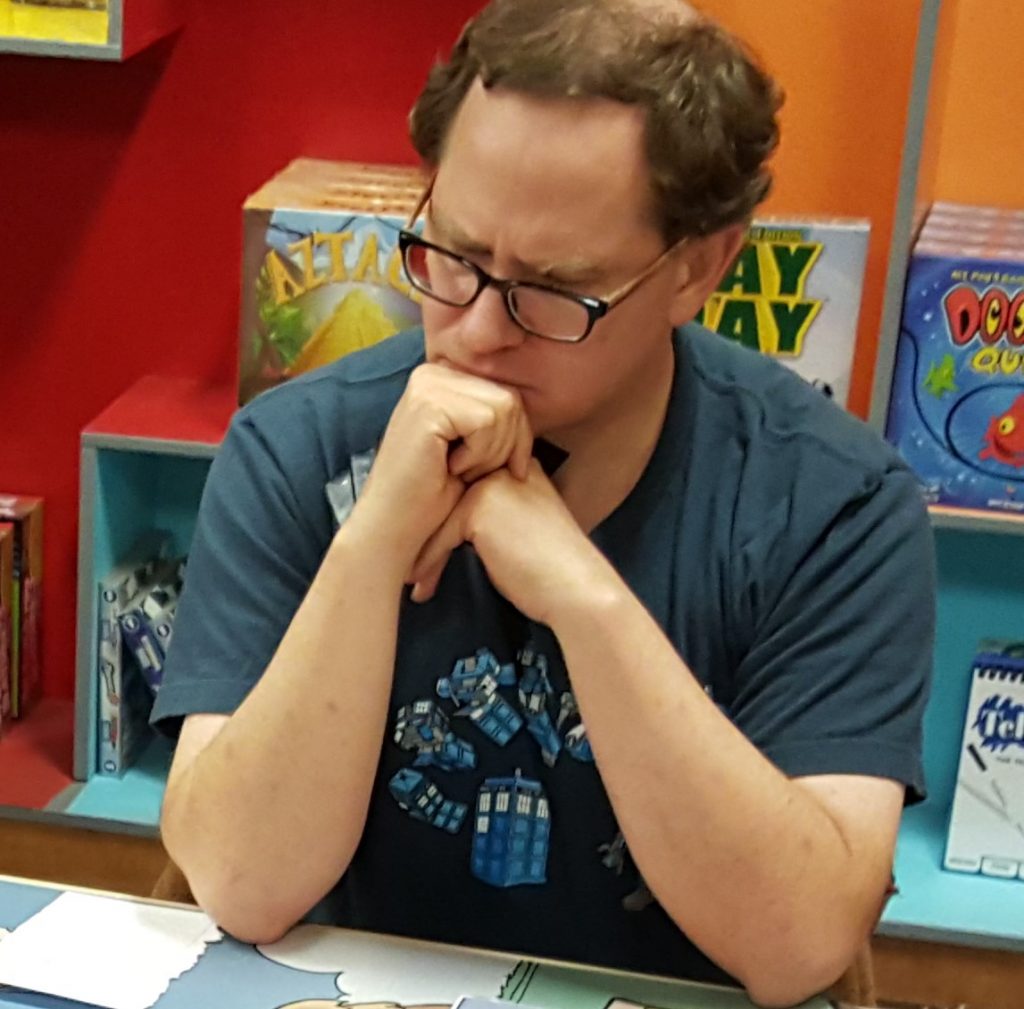
Personal Questions
What’s your backstory? Tell us about how you got into game design.
The earliest I remember working on something that could be called game design was back when I was a teenager learning about a game called “Dungeons and Dragons” (maybe you’ve heard of it?). Game shops were few and far between back then, and I had little to no access to gaming materials. So I would make up ideas for how I thought it could be done, occasionally with some glimpses of materials. I did play D&D a little, including an incredible campaign my first year at college. I also played GURPS, which is a roleplaying system that encourages customization. Also, my brothers and I loved playing board games growing up, which back then mostly consisted of classics like Monopoly or Risk. Later, when my youngest brother found this new game called Magic: The Gathering, I worked through ideas of how to make my own version (without having played it yet). I also grew up through the early days of computer and video games. I still remember the original Legend of Zelda and Ultima on the Nintendo, and had grand visions of making one of those games. Years passed, and I dabbled with various ideas in many formats without really getting anywhere, until I heard about the Guild (see below) and got started on the path of making actual physical prototypes that worked instead of just random ideas. Much easier than trying to learn programming languages or writing enormous rulebooks.
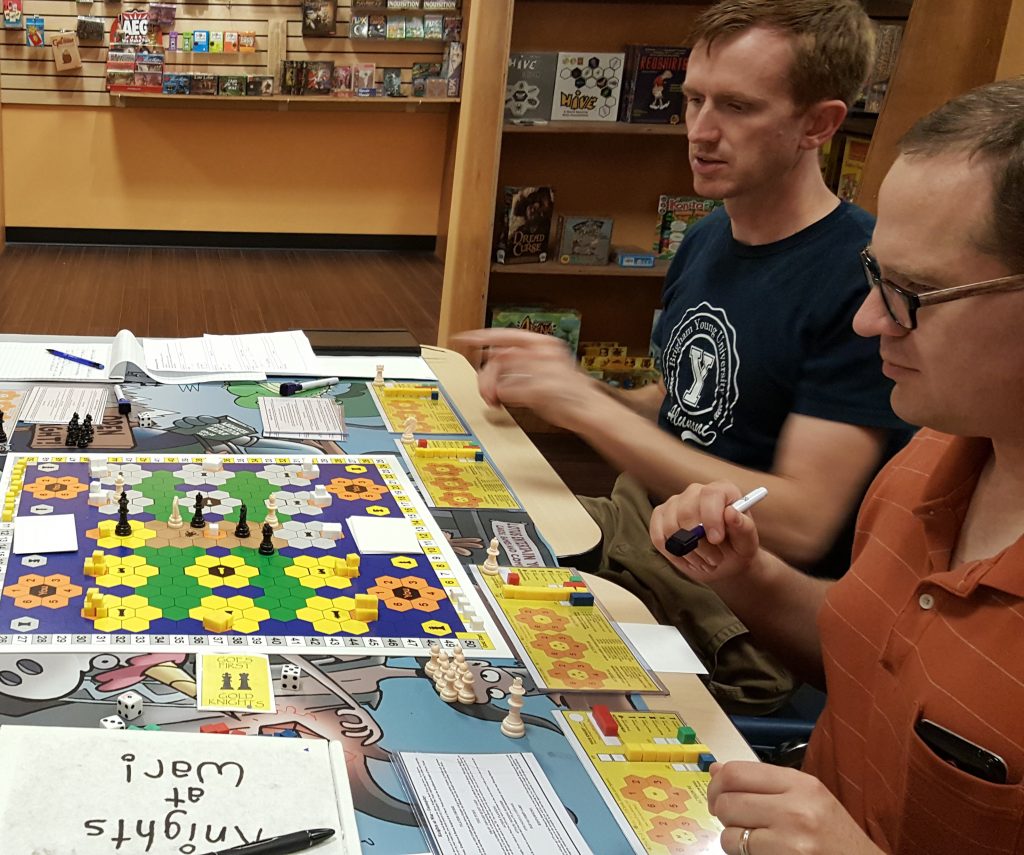
Can you walk us through your design process? Do you start with specific themes in mind or want to utilize certain mechanisms?
When I start on a new design, it’s usually such a swirl of creativity that it’s hard to think what comes first: theme or mechanic? I have had times where I’ve seen an interesting mechanic and wondered what kind of game I could make using it, but more often I have a certain type of game in mind and try to fit the theme and mechanics into that. Sometimes my best ideas come from external inspiration, like the 54-card contest that sparked my creation of Spellweaving 101. Thanks to the Guild, I’ve learned that my best tool to refine my ideas is throwing together a prototype and getting it played. Having real feedback as opposed to just my own ideas in my head really helps to refine ideas into something functional.
It’s my understanding that you are one of the longest tenured active members of the guild. How did you come to be involved with the guild?
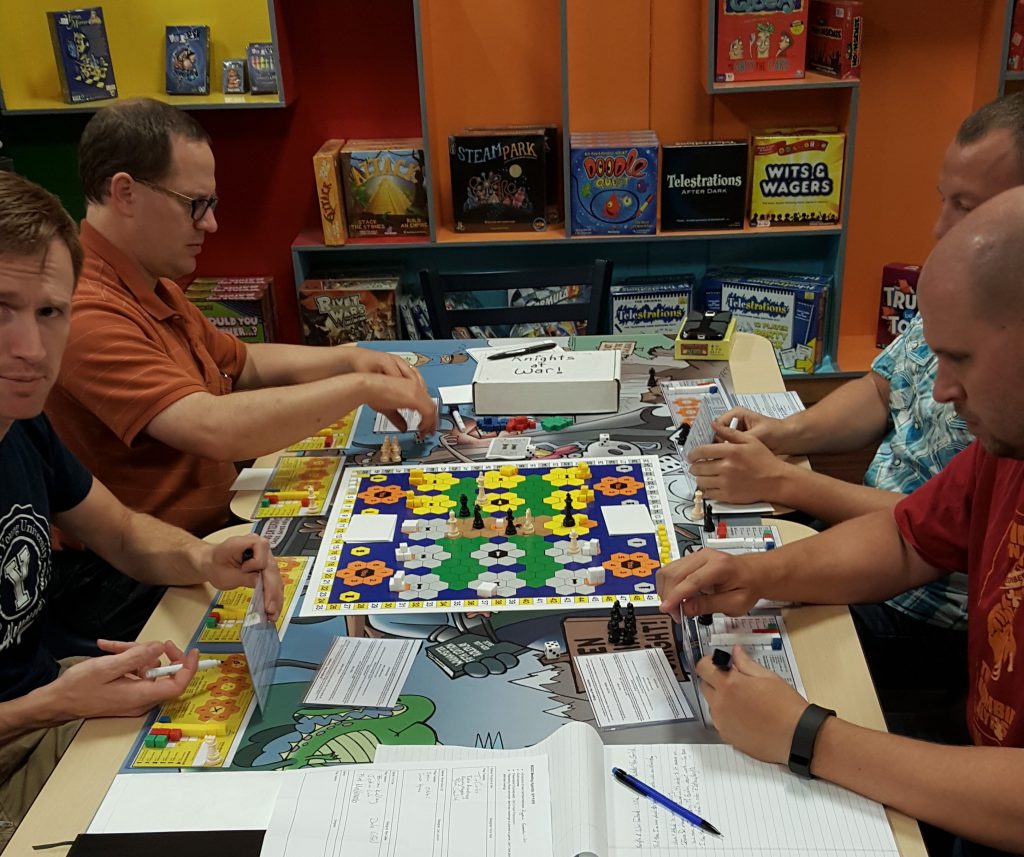
I’m honestly not sure how long I’ve been involved with the Guild now. I remember hearing a commercial on the radio while driving home from work about a new game store opening up in West Valley called Epic Puzzles and Games. Once home, I looked up their website and noticed something about the Board Game Designer’s Guild meeting there (apparently, the Guild had recently moved to that location). When my schedule opened up enough for me to attend a meeting, I went and was hooked. I loved playing prototypes and meeting with enthusiastic players and designers, and soon I was bringing my own games to be torn apart and put together stronger than before. I’ve had a few spots of life interfering with my ability to attend meetings (and this pandemic thing is a big one), but I’m still enjoying meeting and working with others in the Guild.
If you could pick 3 games (together or separately) that every designer should have to play, as a sort of game design curriculum, what would you choose?
I think it’s better to play as many games as you can and see what you like and don’t like. There’s some good and some bad in every game, and that can vary depending on personal taste and play style. When you do find a game you like, try to analyze what about that game makes it fun for you, and see if you can put your own spin on it.
Game Related Questions
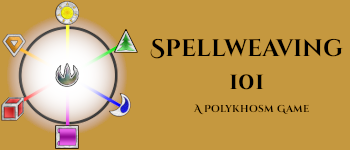
You have been working on a game called Spellweaving 101. Could you tell us more about that game?
You’re an Apprentice Spellweaver, completing your first year of training. Now it’s time for your Final Challenge as you and your fellow Apprentices gather together to show off what you’ve learned by weaving the seven Aspects into powerful Spells. At its heart, Spellweaving 101 is a set collection card game, but it also has special abilities that can also be unlocked by forming the right pairs, combined with just enough take that to keep things interesting.
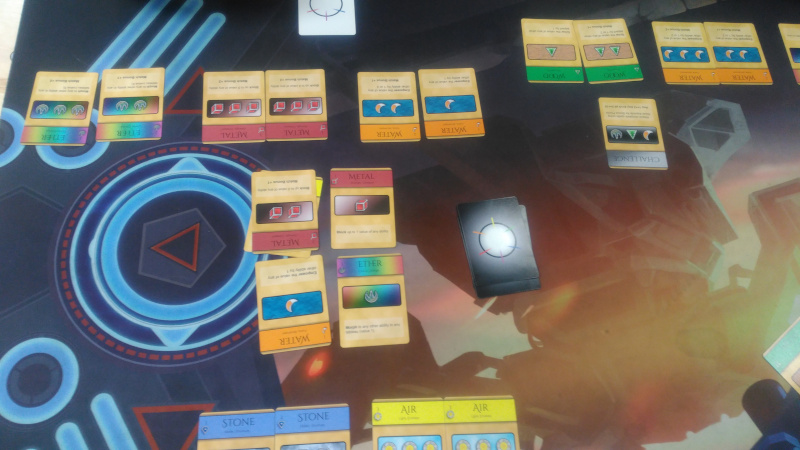
What design challenges did you have to face when designing Spellweaving 101?
I started designing Spellweaving 101 to enter a 54-Card Contest on Board Game Geek. I already had a basic structure for the theme (magic using seven Aspects) and a rough idea for the mechanics (collect pairs of cards), but little else to start. But I knew that making even the most simple prototype and building from there was better than just dreaming of ideas, and so I made a very simple prototype (just numbers instead of any Aspect symbols) and going from there. My wife has been very patient and supportive of my various iterations of the game, and my brother’s graphic design has really made the cards look much better than I could have done on my own. I’ve also recognized the need to be willing to throw out ideas that aren’t working, such as removing rules that don’t need to be there. Playtesting with the Guild and getting feedback when trying out variations on the rules has helped immensely, too (shout out to Lyle for his unwavering support!).
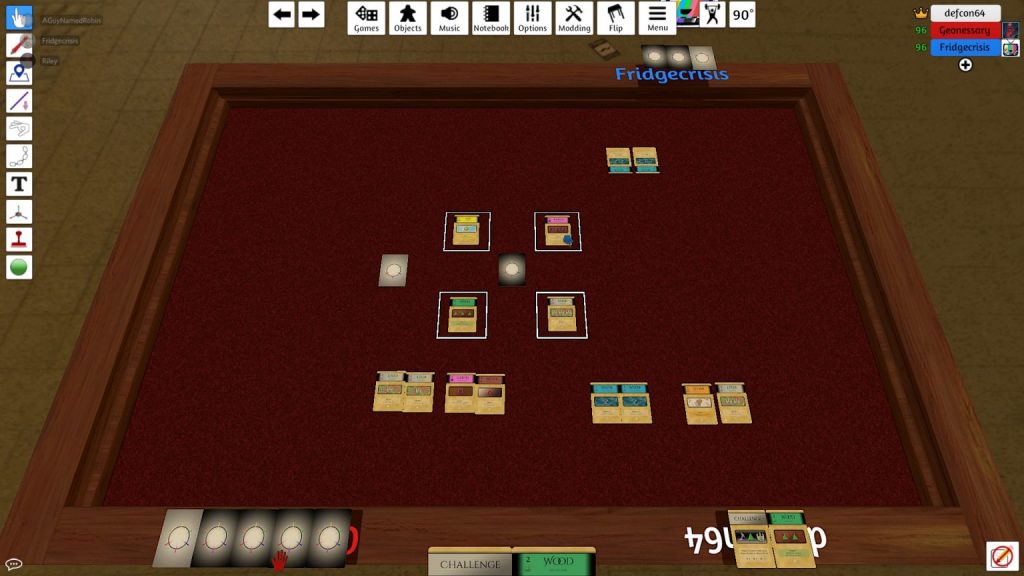
I hear you are building up a mailing list and hope to get to 400 names on that list before launching a Kickstarter. Could you talk a bit about your process in building up a mailing list?
This pandemic has really messed up my plans for making that list! I was all set to do all kinds of events to spread the word and build my list in order to have enough support to start my Kickstarter. I even splurged on getting a table at FanX! (Which I technically still have for 2021…) Now, though, I’m still working on ways to spread the word. My brother and I have started reaching out to board game reviewers to make reviews for us, but the responses so far are slow. To be honest, if anyone has any ideas on how to build my list, I’d love to hear them!
Do you have any other games you’re currently working on?
My grand idea is to build an interconnected world of games and stories I’m calling the Polykhosm, so I’m working on things that help support that. For example, I’m about 60% completed with an expansion for Spellweaving 101, currently titled Spellweaving 201, which will add new Challenges, new Abilities, and new ways to Weave. I’m also reworking an older game I’ve brought to the Guild before (formerly called Ventrada) to work with Spellweaving 101. The idea is to build a game with Characters that have the option to use either that game’s mechanics or Spellweaving to fight each other. It’s all part of my plan for the Polykhosm that I hope I’ll be able to implement with each new game.
Final Wrap up Questions
How would you suppose the guild could improve to better assist in the game development process?
Playtesting is a huge part of game development, and the Guild does that remarkably well (at least when we can meet together). I’m hoping to do more with online playtesting until we can physically meet again, and would love to playtest other members’ games online until then. I’d like to see the Guild grow beyond game development and provide resources for those of us who would like help in figuring out what to do once our games are developed, such as building communities or email lists. 🙂
If people wanted to contact you or follow your game designs how should they go about that?
The best way is to follow my website, polykhosm.com, and sign up for my email list (gotta get that 400!). You can also contact me on Facebook at facebook.com/polykhosm or email me at info@polykhosm.com

